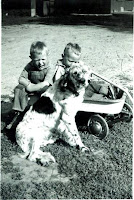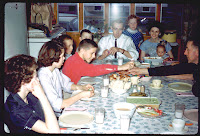
“The Gift Registry” - This is also very interesting to see what they receivedand who gave it to them. You need to keep in mind that this was during the Great Depression and not today. Once again you will more that likely see names that you remember from your childhood.
A transcription is as folows:
Wedding Gifts
Japanese Tea Pot Lena (Coppus) and George Williams
Toweling and Purple Dish Mirth and Lousie (Knaup) Coppus
Blue Table Cloth Betty Kleinhan
Purple Bath Set and Pillow Slips The Hakes (Willis and Civilla (Peter))
Sheets and Pillow Slips Grandma and Grandpa (Daniel and Louisa Peter) Coppus
Ashtray Set Civilla Coppus
Cake Tins Clarence and Erma Coppus
$10 Dad (David Coppus) and Marge
Dress Goods and Apron Dad (David Coppus) and Marge
Rose Cake Plate “Red” Felterman and family
Perculator Mr. and Mrs. I. Ottgen
Granite Kettle Mr. and Mrs. A. C. Heedt and Viola
Green and Pink Bath Towel Set Roy Gifford
Embroidered Pillow Slip Set Mrs. Andrew Meyers
Granite Pan Mr. and Mrs. Arden Mohr
Green Jello Dish and Cake Plate Mr. and Mrs. Justin Bartlett
Green Fruit Dish Mr. and Mrs. Sam Mollosh
Pink Bed Blanket and Green Fruit Dish Mr. and Mrs. Kenneth Domire
Green Measuring Cup, Spoon, Knife,Lemon Squeezer Mr. and Mrs. Maynard Minier
Yellow Fruit Dish Mr. and Mrs. Arthur Ottgen
Pink Jello Set Mr. and Mrs. Woolford Brodbeck
Glass Pie Plate Mr. and Mrs. Sam Ottgen
Orange Dish Mr. and Mrs. Frank Brodbeck
Pink Water Set Mr. and Mrs. Hal Bartlett
Green Tea Pot Fern Paul
Cookie Jar Scott and Hattie (Melroy)
Green Water, Wine and Ice Tea Set Ruth Pooley
Green Ice Tea Set Mr. and Mrs. Paul Dennis, Roy Nicholes, Christine and Cletus
Congoleum Rug Alice (Tripp)
A Dollar Leo Smitz
Casserole Kathryn Radluffe
Yellow Creamer, Sugar Bowl and Cake Plate Eleanor Elwing
Yellow Water Set, Salt and Pepper Shakers Mother and the rest
Green Salt and Pepper Shakers Harry (Tomb - Etta Coppus's boyfriend)
Radio Batteries Mr. and Mrs. Alton Tripp
Chef Salt and Pepper Shakers Mrs. Bartlett in Toledo
Pair of Pillow Slips Mr. and Mrs. George Haislett
Slop Jar Mr. and Mrs. Johnny Glickler
2 Set Bath Towels (Purple and Orange) Mr. and Mrs. Don Haislett
Purple and Blue Bath Towel Al
Dozen Green Water Glasses Mr. and Mrs. Francis Witt
Blue Dish Mr. and Mrs. E. C. Hiatt




















































